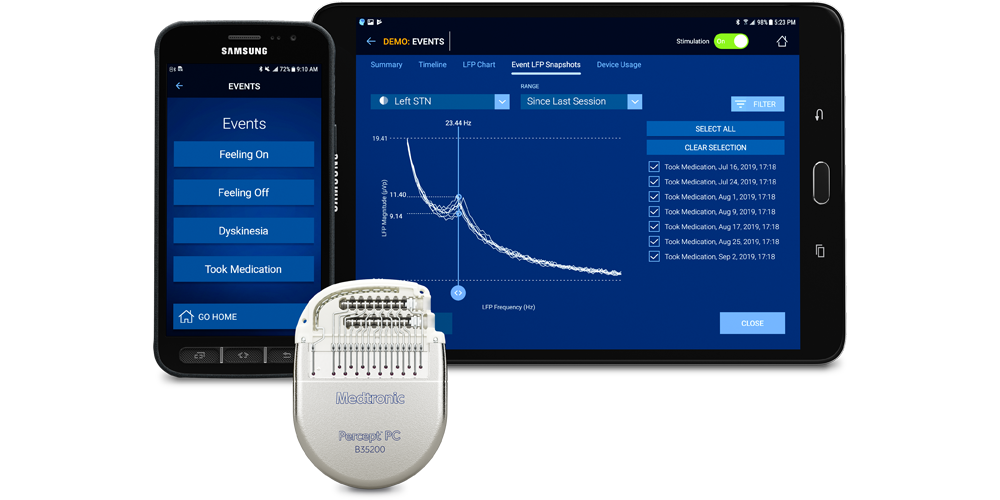Introduction
Watch Nick's DBS Story
DBS Brainsense patient video Nick - (04:49)
Nick, from Bristol, describes how he feels liberated and how he can do more of what he likes.
More information (see more)
Less information (see less)
Keep Doing What You Love
People living with Parkinson’s can often find even small tasks becoming increasingly challenging to achieve. That’s where Deep Brain Stimulation (DBS) comes in.
DBS helps people to stay as independent as possible by helping to control their movement symptoms when their medications aren’t performing.
The Medtronic Percept™ PC Neurostimulator with BrainSense™ Technology means living a fuller life with Parkinson's is possible. You can improve your ability to do daily activities by up to 39%1-4, while reducing drug related complications by up to 61%2-4 with our DBS neurostimulators.
While reading about DBS and its benefits, you should keep in mind the success of Medtronic DBS depends on
- Good candidate selection for DBS therapy. DBS is not for everybody
- Good surgical placement of the DBS electrodes.
Catch the replay of the Webinar with Dr. Whone that was held on April 4th, 2023: Discover DBS and access the newest BrainSense™ technology
Reduce Tremors
DBS therapy has been approved to treat the movement symptoms of Parkinson’s: shaking, stiffness, and difficulty moving.5,6
Live Life
Improve your ability to do daily activities by up to 39%1-4 with our DBS therapy. Patients have reported improvements such as feeling better emotionally, feeling less embarrassed in public, moving about more easily, and having less physical discomfort.
Five Hours More
Good movement control means no troubling symptoms like shaking, stiffness, and difficulty moving. DBS therapy can provide up to five additional hours of good movement control without dyskinesia per day, compared with medication alone.b,2
Ready for the Future
As your Parkinson's condition progresses, the electrical stimulation of DBS therapy can be adjusted without further surgery
Personalise Your Therapy - Get a sense of what's possible
The Percept™ PC neurostimulator, featuring BrainSense™ technology captures and stores brain signals data directly from your implanted SenSight™ directional leads.c Signals can be recorded as therapeutic stimulation is being applied – inside and outside the clinic. BrainSense™ technology may give your doctor real-world data showing DBS therapy in action. Using this data, your physician may adjust your settings – Personalising your treatment to suit your medication and activity levels.
Hear from Consultant Neurologist, Dr. Alan Whone, on DBS.
Dr Whone, Consultant Neurologist - (04:31)
BrainSense™ technology allows recording of electrical impulses from the brain.
More information (see more)
Less information (see less)
"Certainly one of the most exciting therapies to apply is DBS because it has such a very large effect size. (...) It can be extremely satisfying looking after people at that point in their Parkinson’s journey and being involved in a treatment of that magnitude of benefit."
Dr Alan Whone, Consultant Neurologist.
Bristol Brain Centre, Southmead Hospital
Catch the replay of the Webinar with Dr. Whone that was held on April 4th, 2023: Discover DBS and access the newest BrainSense™ technology
Treatment as Unique as You
- The Percept™ PC neurostimulator is designed to provide you with more comfort.d
- 20% smaller than previous generation Activa™ PCe
- 20% thinner than previous generation Activa™ PCf
- It’s smaller and features a battery that lasts longer. g
- It’s the first and only device to have full-body MR Conditional access anywhere on the body for both 1.5T and 3T MRI scans.
View the DBS Systems Comparison sheet


a Number of unique patients implanted (i.e "new patients") as of January 2020
b Measured by the Unified Parkinson's Disease Rating Scale (UPDRS) IV
c Signal may not be present or measurable in all patients
d NDHF1550-188790 Percept PC (model B35200) INS Dimensional Analysis Report, v2.0.
e In overall device volume.
f Refers to case thickness.
g When compared to the previous generation Activa™ PC device. When configured with equivalent settings and no sensing in use.
h Medtronic DBS systems are MR Conditional, which means they are safe for MRI scans only under certain conditions. If the conditions are not met, the MRI could cause tissue heating, especially at the implanted lead(s) in the brain, which may result in serious and permanent injury or death. Before having an MRI, always talk with the doctor who manages our DBS therapy to determine your eligibility and discuss potential benefits and risks of MRI. For further information, please call Medtronic at +44 (0) 1923 205101.
References
- Deuschl G S-BC, Krack P, et al. . A Randomized Trial of Deep-Brain Stimulation for Parkinson’s Disease. New Eng J Med 2006;355:896-908.
- Weaver FM FK, Stern M, and the VA CSP #468/NINDS Study Group. . Bilateral deep brain stimulation vs best medical therapy for patients with advanced Parkinson's disease: a randomized control trial. JAMA 2009;301:63-73.
- Williams A GS, Jenkinson C, et al. . Deep brain stimulation plus best medical therapy versus best medical therapy alone for advanced Parkinson’s disease (PD Surg trial): a randomised, open-label trial. Lancet Neurology 2010;9:581-591.
- Schuepbach WMM RJ, Knudsen K, Volkmann J, Krack P, Timmermann L, et al. . Neurostimulation for Parkinson’s Disease with Early Motor Complications. . New England Journal of Medicine 2013;368:610-622.
- Schuurman PR, Bosch DA, Bossuyt PM, et al. A comparison of continuous thalamic stimulation and thalamotomy for suppression of severe tremor. N Engl J Med. 2000;342(7):461-468.
- Rehncrona S, Johnels B, Widner H, Tornqvist A-L, Hariz M, Sydow O. Long-term efficacy of thalamic deep brain stimulation for tremor: Double-blind assessments. Movement Disorders. 2003;18:163-70